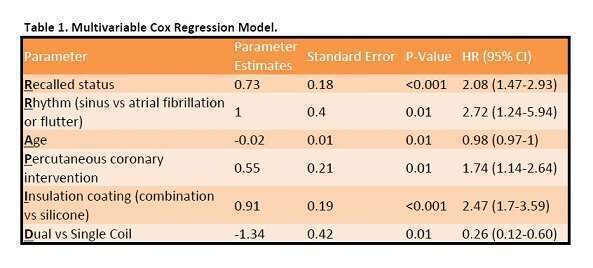
A “RRAPID” Assessment to Determine Implantable Defibrillator Lead Failure
Aims: The purpose of this study was to develop a mnemonic for predicting implantable defibrillator lead failure based on independent risk factors identified in the largest single hospital defibrillator lead failure study (Pacemaker and Implantable Defibrillator Leads Survival Study -- “PAIDLESS”)
Methods and Results: This retrospective study analyzed 4078 leads in 3802 patients over approximately 16 years (1996 to 2011) in order to identify significant risk factors that predict implantable defibrillator lead failure. Data was analyzed using a stepwise multivariable Cox proportional hazard model and identified 6 independent risk factors that increased lead failure (see Table 1). The authors developed the RRAPID mnemonic to represent those risks associated with lead failure (Recalled status, sinus Rhythm, younger Age, history of PCI, combination Insulation, Dual coil).
Conclusion: This study is the first to develop a simple mnemonic (RRAPID) that may be used to predict implantable defibrillator lead failure. This mnemonic provides the physician with a rapid method which is easy to remember that may be helpful in assessing a defibrillator patient’s risk of lead failure. Prospective studies of “RRAPID” are necessary in order to prove the true utility of this mnemonic. In addition, the authors hope to develop a risk adjusted model and scoring system associated with RRAPID.

Powered by Eventact EMS